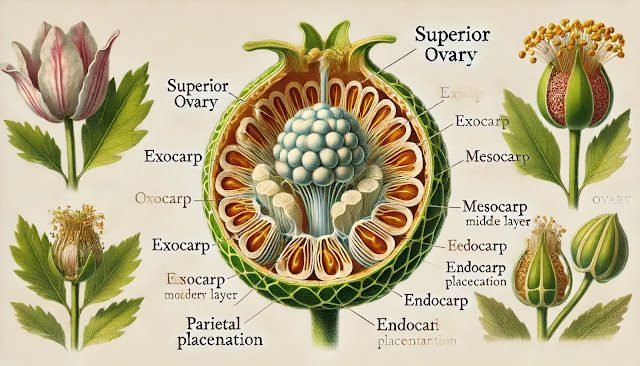Describe the Morphology of Superior Ovary

The superior ovary is a fascinating and critical component of angiosperms (flowering plants) that plays a pivotal role in the reproductive process. Its morphology varies across species, but its general structure and position within flowers hold essential implications for pollination, fertilization, and fruit development. This blog will delve into the intricate details of the superior ovary, exploring its structure, functions, and
significance.
What is a Superior Ovary?
A superior ovary is one that is positioned above the attachment point of other floral parts, such as petals, sepals, and stamens. This arrangement is referred to as hypogynous, a term derived from Greek meaning “under the ovary.” In hypogynous flowers, the ovary is free from other floral whorls, making it a defining morphological characteristic.
Structural Characteristics of the Superior Ovary
The superior ovary exhibits several key structural features:
- Position and Attachment: Located at the apex of the receptacle, the superior
ovary stands distinct from other floral organs. The sepals, petals, and
stamens are all completely above it. - Shape and Size: Superior ovaries can exhibit diverse shapes such as
spherical, ovoid, or elongated, depending on the plant species. Their size
also varies significantly, influenced by the flower’s role in attracting
pollinators or dispersing seeds. - Locules: Internally, the superior ovary is divided into compartments called
locules, which house ovules. The number of locules can range from one
(unilocular) to several (multilocular) based on the plant’s taxonomy. - Ovules: The placenta is a structure that connects ovules to the ovarian wall.
The arrangement of placentation (e.g., parietal, axile, or basal) is a
distinguishing trait among plant families. - Wall Layers: The ovary wall comprises multiple layers of tissues that later
develop into the fruit pericarp. These layers include:- Exocarp: The outermost layer
- Mesocarp: The fleshy middle layer
- Endocarp: The innermost layer, often hard or membranous.
Examples of Plants with Superior Ovaries
Many common plants feature superior ovaries, showcasing the diversity of this floral structure:
- Tomato(Solanum lycopersicum): Although often mistaken for an inferior ovary
due to its berry-like fruit, its superior ovary structure supports
hypogynous flowers. - Lily(Lilium spp.): A quintessential example of a hypogynous flower, lilies
have prominent superior ovaries that develop into capsules. - Mustard(Brassica spp.): Known for its small flowers, mustard demonstrates a
classic superior ovary setup conducive to efficient seed dispersal.
The Role of Superior Ovary in Reproduction
The superior ovary is integral to the reproductive cycle of
plants. Here’s how it contributes:
- Pollination: Its elevated position facilitates effective interaction with pollinators,
ensuring the transfer of pollen grains to the stigma. - Fertilization: Post-pollination, the ovary houses the fertilized ovules, where zygote
formation and seed development occur. - Fruit Formation: The superior ovary undergoes significant changes to form
the fruit. The ovary wall transforms into the fruit pericarp, while ovules
mature into seeds.
Advantages of a Superior Ovary
The hypogynous arrangement of a superior ovary offers
several adaptive advantages:
- Protection: Its elevated position minimizes damage from herbivores and environmental
factors. - Accessibility: The openness of the floral structure allows easier access for pollinators.
- Diversity of Fruits: Superior ovaries contribute to the vast array of fruit
types, from berries to capsules, enhancing seed dispersal strategies.
Comparison with Inferior Ovary
To understand the uniqueness of the superior ovary, it’s
helpful to compare it with the inferior ovary:
| Feature | Superior Ovary | Inferior Ovary |
| Position | Above other floral whorls | Below or embedded in the floral base |
| Flower Type | Hypogynous | Epigynous |
| Examples | Lily, Tomato, Mustard | Apple, Pomegranate, Cucumber |
| Pollination Adaptation | Open access for pollinators | Protection for ovary |
Conclusion
The superior ovary is a marvel of botanical adaptation,
showcasing the intricate balance of form and function in plant reproduction.
Its unique morphology not only defines the classification of flowers but also
influences pollination dynamics and fruit development. By studying the superior
ovary, we gain deeper insights into the evolutionary strategies of angiosperms,
highlighting their resilience and diversity.
FAQs
What is the primary function of a superior ovary?
The superior ovary facilitates the development of seeds and fruits, housing
ovules that undergo fertilization.
What characterizes the superior from inferior ovaries,
which?
The superior ovary is positioned above other floral parts, whereas the inferior
ovary is embedded below them.
What is hypogynous flower morphology?
In hypogynous flowers, the superior ovary is the dominant feature, and all
other floral whorls are attached below it.
Why is the superior ovary advantageous in certain plants?
Its exposed position improves pollinator access and adapts to diverse
ecological niches.
Which plant families typically have superior ovaries?
Families such as Solanaceae, Brassicaceae, and Liliaceae commonly feature
superior ovaries.
Can a superior ovary develop into any type of fruit?
Yes, superior ovaries can produce a wide range of fruits, from fleshy berries
to dry capsules.







